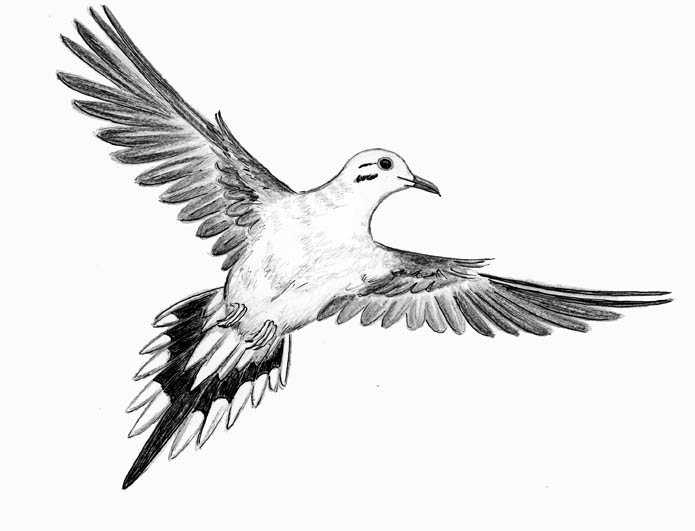
Dear Bird Folks,
Nearly every time I walk out to fill my feeders I accidently surprise a small flock of Mourning Doves, which, in turn, surprise me. When the doves take flight they give off a high-pitched whistle. I’d like to know how the doves make this sound. Is it a vocalization or does the sound come from their wings?
–Simon, Jefferson, NH
I know what you mean, Simon,
We have a big birdfeeder that sits inside one of the windows in our shop. Every morning, while I’m still half asleep, I walk outside to fill this feeder. At least once a week I’m startled by a dove as it bolts out of the feeder, zooming inches away from my face. You might think I’d be used to it by now, but I still jump and end up covered in birdseed. For the rest of the day I have to brush seed out my eyes and hair, and shake it out of my clothes. Even later that night I’m still finding bits of birdseed clinging to me when I crawl into bed. This doesn’t please my wife as much as you might think. But what she really hates is when I open the bedroom window the next morning to let the birds fly in to eat the seed. Apparently, I’m the only real bird lover in the family.
With a population that ranges in the neighborhood of 350 million, Mourning Doves are one of the most abundant birds in North America. I know many folks refer to them as those “stupid doves“ (come on, admit it – you’ve said it), but the truth is they are an extremely adaptable and successful species. They can survive our frozen New England winters as well as the scorching heat of the desert Southwest. Interestingly, in some locations Mourning Doves are appreciated as songbirds, while in other places they are shot for fun. Each year hunters kill nearly twenty million Mourning Doves, more than all other game birds combined. Now you understand why the birds are always “mourning.”
Most birds have an alarm call when danger approaches. We’ve all heard Blue Jays scream their heads off when the dreaded outdoor cat is spotted. Crows do the same when they see a hawk. Doves can’t scream like that. They don’t have much of a vocal range. The only thing they can do is coo. Don’t get me wrong, cooing is fine. I have nothing against cooing, but it’s not a great way to sound an alarm. Try this: The next time there is an emergency, start saying “coooo, coooo.” I doubt those around you will get the sense that there’s trouble (although they may look at you funny). To make up for their lack of a strong voice, they use their wings to announce danger.
When Mourning Doves take flight air vibrates the tips of their flight feathers, which causes the whistling sound. This is not uncommon in birds; most birds produce sounds when they fly. For example, wing sounds are what give hummingbirds their name. Many owls have had to evolve special feathers in order to keep their wings silent when hunting. But what’s special about the dove’s wing sound is its ability to communicate danger; at least, that’s the theory.
To test this theory researchers recorded the wing whistles of a flock of doves during normal takeoff and one during a panicked takeoff. When they played the normal takeoff sounds to a group of doves, as well as to other birds at a feeder, none of the birds paid much attention to it. But when they played sounds of panicked wing whistles, not only did the doves split but all the other birds did, too. It became clear that birds are able to pick up the subtle differences between normal and panicked dove wing whistles. However, it’s still not clear if the doves are able to purposely produce those panicked wing whistles or if they involuntarily generate these sounds during a frightened takeoff. More research is needed to answer that question, which is good for the researchers. If there is one thing researchers love, it’s more research.
It is known, however, that male doves can purposely create non-vocal sounds to help them attract a mate. Typically, a Mourning Doves flight is fast, smooth and direct, but during the mating season a male dove exhibits a behavior known as “flapping/glide flight.” At first, the male sits on a branch and does the same old boring cooing, which never seems to work. Then he suddenly takes off and flies awkwardly, like he is under the influence of something that is tax-free in New Hampshire. His wing beats are exaggerated, aggressive and extremely noisy. He’ll continue this noisy flight until he reaches a height of about 100 feet. At this point, he’ll regain his composure, go into a controlled glide and gently coast back to the branch where it all began moments earlier. What dove babe could resist all that?
The high-pitched whistles produced by Mourning Doves definitely come from their wings, Simon. These wing sounds are an effective way to attract a mate, announce danger and startle predators. While these wings sounds can be very loud, they aren’t nearly as loud as my wife’s voice when I let the birds inside to eat birdseed out of our bed. Some people are so uptight.